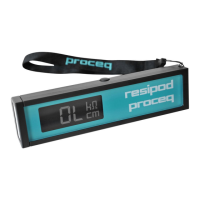3 Measuring Resistivity with Resipod
Preparing the concrete surface
The concrete surface must not be coated with any electrically insulating coating, and it should be
clean. The rebar grid beneath the surface should be marked out with the help of a rebar locator
(e.g. Profoscope). If the concrete is completely dry it will not be possible to make a measurement
as the current is carried by ions in the pore liquid, (See 2.2). Therefore it may be necessary to wet
the surface.
3.1 Making a Measurement
A good connection between the
instrument and the concrete surface is
the most important factor for obtaining a
reliable measurement. Dip the contacts
in water several times before making a
measurement – use a shallow container
so you can press against its bottom
– this will fill the reservoirs. Press the
Resipod firmly down until the outer two
rubber caps rest on the surface to be
tested.
Indication of poor connection
In the case of a poor connection, the Resipod will display one of the following alerts.
“Open Line” indication
Bad connection of the two outer probes to the concrete
surface. No measurement possible.
Inner two probes are not making contact.
(check for holes or dry spots on the specimen)
Or Sample resistivity <1kΩcm
Material resistivity is extremely low.
Overflow
The measured resistivity is out of range. This limit is
dependent on the spacing, but it is typically a resistivity of
>1000 kΩcm.
Contact selection
The steel probe tips are rugged and may be used to scratch away a thin layer of plaque on the
surface in order to make a better connection. The size of the contact however, means it is not
always possible to drive the full 200µA into the concrete to obtain the maximum measurement
resolution.

